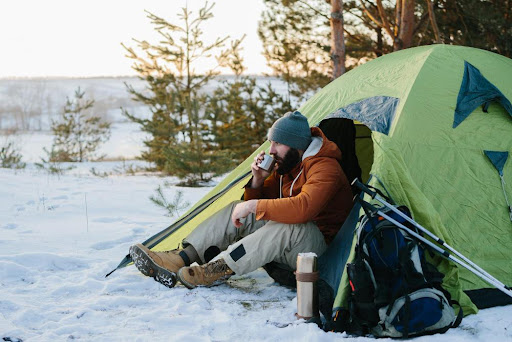Are you an outdoor lover? Do you swear by camping, glamping and other outdoor recreational activities? We are and do too!
Some say camping is a weather-conscious activity and is most profitable when the weather is bright and fair. But we say even in the winter, when it is cold and snowy, you can enjoy your favourite activity in a bell tent out in the snow, any day or night.
However, using a bell tent in the snow comes with its challenges. From setting it up to maintaining it, you might experience a few ups and downs, but lucky for you, there is a solution for every problem with using a bell tent in the snow.
Here are five challenges and their solutions to using a bell tents in the snow:
1. Indoor snow
You’re likely to get some stray snow into your bell tent, notwithstanding shutting the doors and other openings to keep the tent warm. So what do you do?
Solution: Using a tent stove as a heater, keep the insides of your tent warm, which will fast-track the melting away of the snow that got away – any snow that seeps into the interiors of your tent.
2. Lack of ventilation
You most likely will choose to shut the windows, doors and air vents while in the snow. But this will only restrict ventilation and form condensation along the interior walls of your tent.
Solution: Open up just a couple of tent airways for ventilation and simultaneously run your tent heater to keep you warm.
3. Snow build-up
With different types of snow come different weights. When there is a snow build-up on your tent, it can fall apart under the weight of the snow, especially if yours have light frames that can’t withstand the weight.
Solution: Get studier support systems for your tent frames, like a solid centre tent pole. Take a step further by regularly shovelling away accumulated snow around your tent’s perimeter
4. Mould and mildew
Depending on the material of your Boho bell tent, it may get worn out from water damage. How? Moulds and mildew may grow on your tent from snowmelt and damage your tent. Continual cycles of water damage will ultimately ruin your bell tent.
Solution: Most tents are made from pure cotton, which is most susceptible to water damage from snowmelt and rarely waterproof. To beat this, go for polycotton or polyester tents, which are perfect for wet weather; use a fly cover or rain fly over your tents to protect them from the snow and other elements or better still, stick with your cotton tents but get them waterproofed before going out in the snow.
5. Heavy winds
Camping out in the snow comes with other perks, like struggling with the winter wind. A mighty wind might pull down your tent. To prevent the crashing of your bell tent, which you have painstakingly set up,
Solution: Set up your tent on a flat surface (as slopey grounds are avalanche-prone and thus risky) and also under sturdy trees to be sheltered from the strong winds.
Now mate, while camping even in the winter is super fun, remember to stay safe out there by getting all fully prepared and geared up for the cold nights. With the right gears plus a solid Boho bell tent, you are assured an adventurous time out in the snow!





Be First to Comment